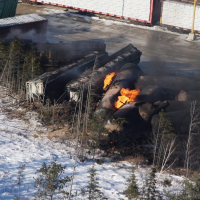Brown Budget Anticipates Surge in Inland Oil Spills from Out-of-State Rail Transports
 Train derailment in New Brunswick, Canada (photo: Tom Bateman, Associatied Press)
Train derailment in New Brunswick, Canada (photo: Tom Bateman, Associatied Press)
Last November, a train carrying 2.7 million gallons of crude oil derailed and exploded in rural Alabama, dumping 21 flaming cars into a marsh, befouling wetlands and igniting a blaze. And last week, a 122-car train derailed in New Brunswick, Canada, dumping oil from five of the cars, catching fire and forcing evacuations.
They were not unusual occurrences in the oil transportation business and, if Governor Jerry Brown’s proposed 2014-15 budget is any indication, it will soon be a regular feature of the California landscape. He has asked the Legislature to approve an additional 38 staff members and $6.7 million for the Office of Oil Spill Prevention and Response in the Department of Fish and Wildlife. The office currently employs 245 people.
Although California pumps a lot of oil, it is a major refiner of other people’s crude and a net importer. According to the California Energy Commission, the state produces only about 37.2% of the petroleum it uses. But the overwhelming majority of imports have come via ocean transports (two-thirds) and pipeline (one-third). In 2012, only 0.2% of the 598 million barrels of oil arrived by rail.
That is already changing. The commission expects rail to account for a quarter of imports by 2016 as oil production in the West booms and producers look for refiners. And, of course, tar sands oil from Canada looms as Alberta looks to ship the world’s dirtiest petroleum product to the Gulf Coast via the controversial Keystone XL pipeline and California via trucks and rail.
Railroads are carrying 25 times more crude oil nationally than they were five years ago and the increase is reflected in oil spill incidents.
There were no reported incidents of California crude oil spills during transportation in 2010, according to the U.S. Department of Transportation’s Pipeline and Hazardous Materials Safety Administration (PHMSA) database. Only eight “serious” incidents have been reported since January 2000, all on the highway. There were four nonserious incidents in 2011 (three by rail) and seven in 2012 (three rail, four highway).
But that changed in 2013. Twenty-five incidents involving crude oil, none serious, were reported and all of them were by rail. Fish and Wildlife Director Chuck Bonham told McClatchy Newspapers the change is inevitable. “We’ve exceeded pipeline capacity, and that distribution is now shifting to rail,” he said.
Infrequent trainloads of crude are being brought to refineries in Richmond and Bakersfield from North Dakota by BNSF Railway, but McClatchy said that will probably change when six new refinery locations are retooled to accept rail shipments. Five or six 80- to 100-car trains a day are envisioned hauling in 25% of California’s oil needs.
The threat from rail oil spills is exacerbated by the type of crude expected to be delivered. Although the big fear is that the estimated 171.3 billion barrels of Canadian tar sands, with a carbon footprint 10-20% greater than other oil, will start to flow this way, flags have been raised about the product coming out of the American West.
Oil from North Dakota’s Bakken area is said to be considerably more flammable than conventional crude. And, according to Environment and Energy Daily, transportation experts warn that the aging train cars are susceptible to rupture and puncture in a derailment.
–Ken Broder
To Learn More:
California Expects More Crude Oil by Rail, Seeks to Beef up Spill Response (by Curtis Tate, McClatchy)
Crude Oil Spills Are Bigger from Trains than Pipelines (by Leslie Young, Global News)
Crude Mishaps on Trains Spike as Rail Carries More Oil (by Mike Soraghan, E&E News)
A Toxic Nightmare: The Dunsmuir Metam Sodium Spill Revisited (by Ed Gherman, Sonoma County Free Press)
The Quiet Plan to Bring Toxic Canadian Tar Sands to California Refineries by Rail (by Ken Broder, AllGov California)
- Top Stories
- Controversies
- Where is the Money Going?
- California and the Nation
- Appointments and Resignations
- Unusual News
- Latest News
- California Forbids U.S. Immigration Agents from Pretending to be Police
- California Lawmakers Urged to Strip “Self-Dealing” Tax Board of Its Duties
- Big Oil’s Grip on California
- Santa Cruz Police See Homeland Security Betrayal in Use of Gang Roundup as Cover for Immigration Raid
- Oil Companies Face Deadline to Stop Polluting California Groundwater





